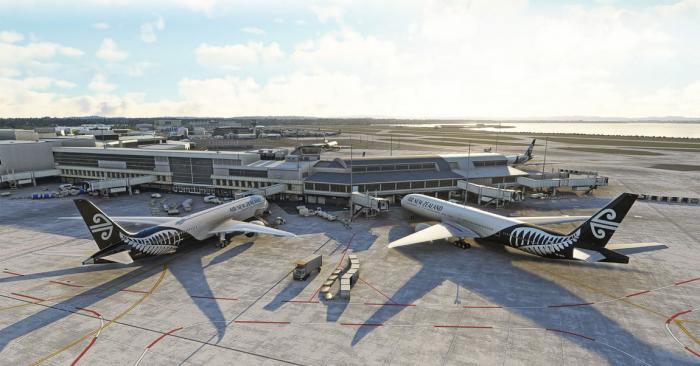"Kia Ora and welcome to Tamaki Makaurau.”
This is the greeting you’ll often hear over the PA on landing in Auckland International (NZAA). The airport is located on the southern shores of New Zealand’s biggest city, Auckland, and serves as the country’s primary gateway to the rest of the world.

Auckland airport’s history
The site first saw flying activity back in the 1920s when the newly formed Auckland Aero Club sought out a large flat field outside the city to be their base of operations. Named Mangere Aerodrome, the site remained relatively untouched through to the 1960s, with the paved runway aerodrome at RNZAF base Whenuapai, serving as the city’s primary airport during the first half of the 20th century.
After substantial redevelopment, including reclaiming land from the adjacent Manukau Harbor to form the original 2,590m runway, Auckland International Airport was officially opened with a grand celebratory pageant in January 1966.
As demand for air travel steadily increased over future decades, a second terminal was constructed exclusively for international flights, named the Jean Battern terminal, with the namesake officially opening the building in 1977. The New Zealand-born aviatrix broke several pioneering aviation records and was the first person in the world to fly from England to New Zealand back in 1932, taking 11 days in a single-seat Percival Gull. She landed at Mangere to finish her journey, and her aircraft is now proudly displayed inside the arrivals hall of the building, hanging from the ceiling to greet passengers as they arrive as a reminder of how far air travel has come.
The present-day airport is served by a singular runway, aligned 23 – 05, which has since been lengthened to 3,635 x 45m and is suitable for handling aircraft right up to Airbus A380 size. For a while, the airport held the record as one end of the world’s longest non-stop commercial flight between Doha and Auckland with a distance of 14,535km.

Auckland Airport users
Prior to the COVID pandemic, the airport served 26 domestic destinations and boasted connections to 49 international destinations with flights departing to and arriving from every continent in the world. A total of 21 million passengers a year passed through the complex, with the likes of Jetstar, Qantas, Virgin Australia, Emirates, Singapore Airlines, Cathay Pacific, LATAM, American Airlines, United Airlines, China Southern and China Eastern among others all operating scheduled routes from Auckland.
New Zealand’s flag-carrier airline, Air New Zealand, is the biggest user of the airport and has its primary hub at Auckland with the majority of its international routes all arriving and departing from NZAA. The international freight and passengers that travel on these routes are all fed through a busy domestic network to meet these flights, with New Zealand having an unusually high amount of internal air travel for a nation of its size. This is primarily due to the country’s mountainous island geography that makes surface travel much more time-consuming and early infrastructure prioritising regional airports over highways and railways.
The airport also plays host to Air New Zealand’s heavy maintenance base, along with dedicated freight facilities, two fixedbase operators (FBOs) for handling private business jet traffic and further hangarage and support for air ambulance and other general aviation aircraft.
Auckland is generally considered a pilot-friendly airport to operate from, with open water to the south and west, and flat urbanised land to the north and east.
Prevailing winds are out of the southwest, with the runway orientated into them and the Auckland climate rarely sees unflyable weather. Springtime fog can sometimes sit in Manukau Harbour and drifts on and off the runway but the airport is equipped with the region’s only CAT III B ILS system, allowing for suitably trained crew to conduct landings with a zero feet cloud base and just 75m forward visibility should these conditions prevail.
Flightbeam’s Auckland
Flightbeam first announced it was working on a digital rendition of Auckland back in August 2016 and it was over four years and 317 days before the first version of this appeared for Prepar3D v4 & v5. Not long after, beta testing commenced for the Microsoft Flight Simulator (MFS) version which I was fortunate enough to participate in being a real-world pilot based out of NZAA for my day job. Thankfully the scenery is fully compatible with Orbx’s Auckland Landmarks and NZ Mesh.
Seeing an accurate version of the airport in the simulator for the first time certainly was a long time coming but well worth the wait. In order to achieve what Flightbeam proclaims to be the most detailed terminal exteriors of all its products, lead developer Mir had a full airside survey conducted with permission from Auckland Airport management.
Attention to detail
Based on the data collected, the airport buildings have been recreated in meticulous detail in collaboration with 3DReach. Both the domestic and international terminal buildings have been extended and remodelled multiple times throughout their lifespan, so the present-day structures are anything but linear and simple to digitally model.
The roofing of both the terminals and engineering hangars are particularly complex and it boggles my mind to think how challenging these would have been to reconstruct for the sim. A lot of the 3D renders have also been hand-painted too, creating an extremely immersive experience no matter where your camera is positioned or how close you zoom in within the simulator. On top of all this, all surfaces, including aprons, taxiways and runways are finished with 4096x4096 Physically Based Rendering (PBR) materials and look simply outstanding with low angle sunlight or in reflective rainy conditions within the simulator.

The custom structures don’t just finish on the airport perimeter either - they extend way out to the north, including various storage warehouses, car parks, office complexes, hotels and shopping centres that surround the airport. These all sit upon a much higher resolution colour-corrected photographic ground plate that replaces the default surface textures and blend in seamlessly with the surrounding Bing Maps coverage. The annoying autogen tree forest that flanks the runway in the default Asobo NZAA has thankfully been cleared and an aesthetic water mask for the various harbour inlets around the airport shoreline has been included too.

Animated jetways are featured throughout, fully interactive within the MFS interface and show the wear and tear that match their real-world counterparts. Custom taxiway and approach lighting has been included, accurate to the lighting colours and intensity published in the New Zealand AIP and verified by pilot testers. I could write a whole article on the night lighting alone but suffice to say it has been done justice and the airport looks just as good after dark as it does during the day.

The iconic 1960s control tower has been faithfully built to scale and features a detailed cab interior for simmers who enjoy role-playing as virtual ATC. A second smaller cab, known as ‘Apron Tower’, that controls aircraft ground movements, is located above the roof of the international terminal pier and has had its inside accurately modelled too.

Interior details
The interiors of both terminal buildings remain largely untouched however, as there are not many locations around the airport where the inside can be viewed clearly. There are a few exceptions to this, with floor-to-ceiling glass on the main pier of the international terminal, and along the south-facing aspect of the domestic terminal - adjacent to the jet bridges. In these positions, Flightbeam has included limited modelling but tinted the glass darker than it appears in the real world to mask the lack of details. Given the overall scale of the airport reproduction, this does not bother me personally as it means less of a performance hit to my graphics card with less polygons to render in frame. I’m not sure what wizardry Mir has done behind the scenes, but overall, optimisation of the scenery is phenomenal with stable high frame rates and no trace of stuttering at NZAA.

Adding ‘life’ to the airport
Ground clutter has been added throughout the scenery, both landside and airside, giving the airport a much more busy feeling than the sterile automatically generated airports we sometimes see in MFS. The ground service vehicles have been textured in their appropriate liveries, along with familiar branding on the likes of pushback tugs, buses and baggage cargons. The signage for the taxiways, gates and roadways all feature the correct font, a subtle difference from default that makes all the difference when you compare Flightbeam’s work with Asobo’s. Optional static aircraft can be selected on or off through the Contrail software interface from which the scenery can be purchased and installed via. These static aircraft include both Air New Zealand wide-body and narrowbody airliners, parked at the correct stands and gates as are used in the real world, along with several ATR72 regional turboprops at the correct gates on the eastern end of the domestic terminal.
After feedback from the Kiwis in the testing team, some additional static aircraft that are frequently seen in Auckland were added, including a FedEx MD-11 and a DHL 767 freighter. Air Chathams’ mixed fleet of Convair CV580s, Saab 340s and Fairchild Metroliners are all parked on taxiway Charlie 1; an area affectionally dubbed ‘Convair Corner’ that are always visible in one’s peripheral vision when crossing the threshold to land on Runway 23L.
Going forward, Flightbeam has promised free updates to the scenery, including Visual Docking Guidance Systems for each gate, animated passengers and workers, as well as updates to the building models to reflect the state of the terminals as of 2022.
Conclusion
No matter whether you enjoy long-haul flights, mid-haul or shorter sectors, you can’t look past Auckland as a virtual destination for your MFS library. The scenery represents years-worth of expertise and hard work all rolled into one product, and the finish is outstanding.
PC Pilot Verdict:
At a glance: Five years in the making -one of the most comprehensive international airport add-ons we’ve ever seen in a simulator.
Publisher and Developer: Flightbeam
Distributor: Contrail App
Price: $18.99 (£14 approx)
Website: www.flightbeam.net
3D Modelling: Great
Graphics: Excellent
Documentation: Basic
Performance: Excellent
PC Pilot Score: 95

Review System
Processor: AMD Ryzen 7 3700X, Graphics: NVIDIA GeForce RTX 2070 SUPER 4095MB VRAM, RAM: 32GB DDR4 RAM, Hard drive: Samsung 970 EVO 500GB SSD

